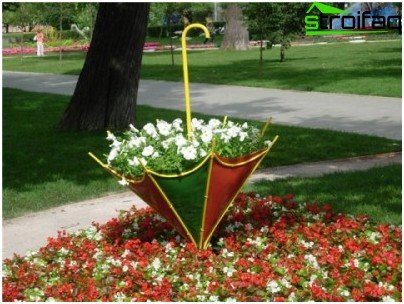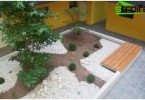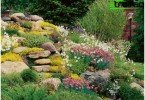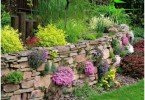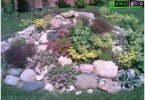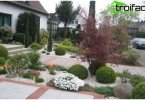The theme of flower beds currently breaks all records of relevance. This is because people go to the country not only to plant and dig potatoes. A piece of their own land attracts everyone with the opportunity to create their own paradise for relaxation. And what comfort can be without a flower garden and the aroma of your favorite plants? Not every housewife knows how to make a flower garden in the country, so many turn to professionals. But if you try hard and connect your imagination, you can save money and it’s nice to surprise yourself. So much so that all the neighbors get jealous.
Content
- Types of flower beds.
- How to make a flower garden.
- How to achieve color harmony
Types of flower beds
In order to create a flower garden itself, you need to have a desire and a little knowledge. As a rule, country flower beds are presented in the form of some kind of geometric figure, but it all depends on the owner’s creativity. The availability of the Internet provides the basis for the birth of new ideas. Here you can find a thousand different decorations, from cascading products from machine tires, to an old bed sprouted with flowers. To make a real work of art, you first need to decide where you want to arrange the flower garden. The light of the sun and the views of the guests must necessarily get into the chosen place. Among the main types of flower beds, regular, free and longline can be distinguished. Regular have a stationary clear layout and are divided into garden borders, flower beds, discounts and stalls.
- Garden borders are stripes of plants about half a meter wide, which frame lawns and paths.
- Flowerbeds – geometrically regular areas, planted with flowers, most often in the form of a rectangle, circle, square or rhombus.
The theme of flower beds breaks all records of relevance
- Rabatki are long flower strips up to three meters wide, often consisting of several rows of plants. Usually, rabatki are located around the perimeter of some objects. The length of the worker should be approximately three times greater than its width.
- Parterre is a composition of flowers and any inanimate elements: sculptures, sand or stones.
- Free flower beds belong to such a landscape layout that does not have clear smooth lines. The most popular of them are mixborders, rock gardens and groups..
- Mixborders are mixed flower beds having various shapes and a large number of plant varieties, often planted with patterns.
- Rock gardens are flower beds founded near such elements of nature as streams, ponds, rocky hills or wild plants. A striking example of rock gardens are flower beds on stones, the so-called alpine hills or rockeries.
- Groups – floral arrangements of different shapes, located on level ground.
- Layered flower beds are elevated flower beds planted with stairs. Special garden flowerpots for them can be bought in a store or laid out of stones with your own hands. The simplest and most common option is car tires of different sizes, lined with a pyramid.
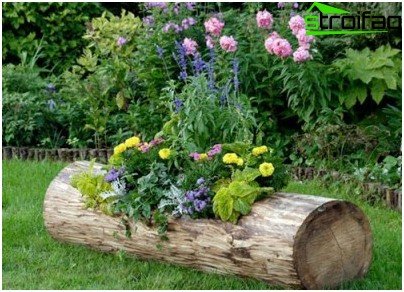
The flight of fancy when creating a flower garden is unlimited
How to make a flower garden
- Choose size and shape
To make a flower garden, first of all, you need to prepare a planting scheme for plants, choose their varieties, determine the quantity. The size and shape of the flower garden depends entirely on the size of the plot allocated for the garden. If the territory is large enough, experts recommend creating several different compositions of flowers.
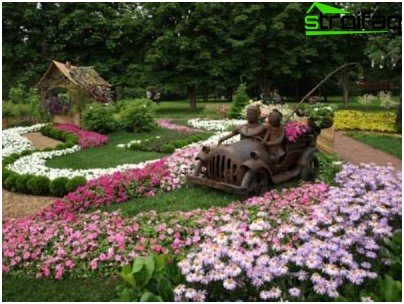
Regular flower beds have a clear layout
- We take into account the flowering time
In order for the flowerbed to bloom continuously, it is very important to plant it at the same time as early flowering, medium flowering and late flowering plants. With little experience in creating flower beds, flowers that bloom from late May until the first frosts, such as marigolds, salvia or fragrant reseda, are ideal. Early flowering plants include crocuses, daffodils, pansies, saxifrage, tulips, primroses and incense. These flowers delight the eyes from April to June. Blossom from the end of June to August: Purslane, Japanese astilbe, phlox, bluebells, petunia, alpine bluehead, garden chamomile. Since August, most species of asters begin to bloom, stonecrop prominent, and chrysanthemums.
- Do not forget about the height of plants
It is very important to consider the height when landing. On a round flowerbed in the center, it is worth planting the tallest plants. Borders, mixborders and one-sided flower beds adjacent to the fence are planted with highly growing flowers in the background. The closer to the foreground, the lower the plants should be, you can complete the composition with groundcover flowers. The highest flower beds are poppies, delphinium and cosmea. With proper care, they reach 80 cm. A little lower, 60-70 cm – cornflowers, phlox and zinnias. Dimorph library, calendula and marigolds reach only 30 cm.
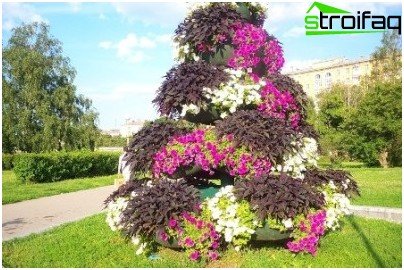
Longline flower beds are elevated flower beds planted with stairs.
- We take care of the illumination of the plot under the flowerbed
When choosing plants for a flower garden, it is necessary to take into account the illumination of the flower bed. Indeed, some flowers love the sun, while others do not. Light-loving plants include salvia, lupins, dahlias, peonies, phloxes, gladiolus, rudbeckia, dolphiniums, marigolds, petunia and calendula. Comfrey, tiarella, periwinkle, fern, nasturtiums, balsamins, daisies, aconites, daylilies, astilbe and lily of the valley are shade-loving flowers. There are plants that grow well in the shade and in the sun – these are aquilegia, lilies, pansies, irises, brunners and cornflowers.
- Separate moisture-loving and drought-resistant flowers
Another very important factor when choosing flowers for a flower bed is the ratio of plants to moisture. Rudbeckia, forget-me-not, astilbe, frankincense, peony and a leotard die without regular watering. Drought-resistant are marigolds, asters, eschscholzia, cosmea, purslane, saxifrage, stonecrop.
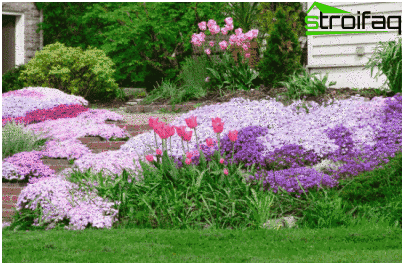
The landscape layout of free flower beds does not have clear lines
How to achieve color harmony
In general, when planting a flower garden, you simply have to cherish your desires and tastes. But take into account some aesthetic moments still have to. The main colors on the flower bed are red, yellow and blue, the remaining colors are complementary. White is combined with any colors, both with the main and with additional.
Monotonous flower beds look very impressive. For example, if you have tiered flower beds in your garden, make one red, one yellow and the third blue. It is not necessary to use one type of plant, the main thing is to choose colors.
Two-tone combinations of yellow and purple, blue and orange, green and red look harmonious. Also interesting are the transitional combinations from red-orange to yellow, from blue to violet-blue. Pink, merging with pale blue, turning into yellow-lemon – this is a hit combination. These tones are suitable for resting places, positively affect the nervous system and create cosiness in the garden..
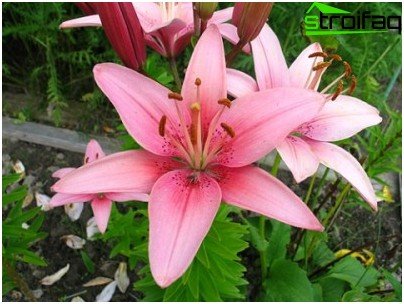
Any plants need to be planted with love
Do not forget to dilute the composition with greens, which will decorate the flower bed before it blooms. There is another important rule for creating a flower garden: any plant needs to be planted with love, then it will answer you the same. Imagine, improvise and be happy!


